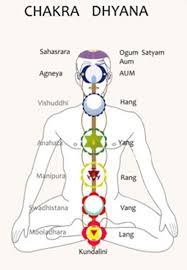|
Psychic Energy Channels (Nadis)
According to Shiv Samhita there are three and half lakhs of Nadis in the human body and according to Gorakh Samhita, there are 72,000 nadis (energy channels) extending out from the spinal cord. The three most important nadis or psychic nerves (Ida, Pingala and Sushumna) are the energy channels which pass through spine and connects the perineum and brain. The three paths are also known as ganga (Ida), Yamuna (Pingala) and Saraswati (Sushumna). The psychic energy channels – Ida and Pingala, are the two nadis which play an important role in controlling the parasympathetic and sympathetic nervous systems respectively. These nervous systems act largely unconsciously and regulates bodily functions, such as the heart rate, digestion, respiratory rate, pupillary response, urination, sexual arousal etc. As per modern scientists, the human body has four types of biological rhythms – circadian (24-hour cycle), diurnal (day-night), ultradian (90 minutes) and infradian (over 24 hours). The ultradian rhythm is directly related to Ida and Pingala. Ultradian rhythm relates to periodic swings of mood, mental alertness, stomach contractions and many other physical and mental changes. This rhythm plays an important role in cognitive performance, memory processes, visual perception, levels of arousal and performance, mood, and individual and social behaviour. Inhalation from left and right nostrils changeover periodically. Those people, who live near nature, generally have 90 minutes rhythm. But many factors modify this rhythm. In pranayama and meditative practices, the flow of inhalation in each nostril renders equal which induces the ideal situation for meditation. During 24-hours day, flow through the Ida should pre-dominates for about 12 hours and the Pingala also for about 12 hours. During daylight hours, the Pingala generally pre-dominates and Ida tend to predominates during sleep at night. The path of Ida is concerned with the tendency to unleash mental powers, which are often used for selfish ends. The path of Pingala – the path pravarti marg – the path of external action and enjoyment. It is the path where one acts in the world mostly for personal gains. Ida energy channel:
Pingala energy channel:
Kundalini: In the Sanskrit the word Kundalini has two words – Kundala which means ‘coiled’ and Kunda which means ‘a pit’, ‘depression’ or ‘deeper place’.
0 Comments
Leave a Reply. |
Archives
July 2024
Categories |

 RSS Feed
RSS Feed